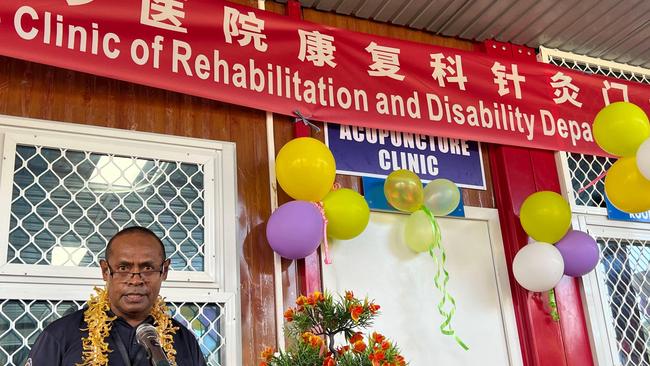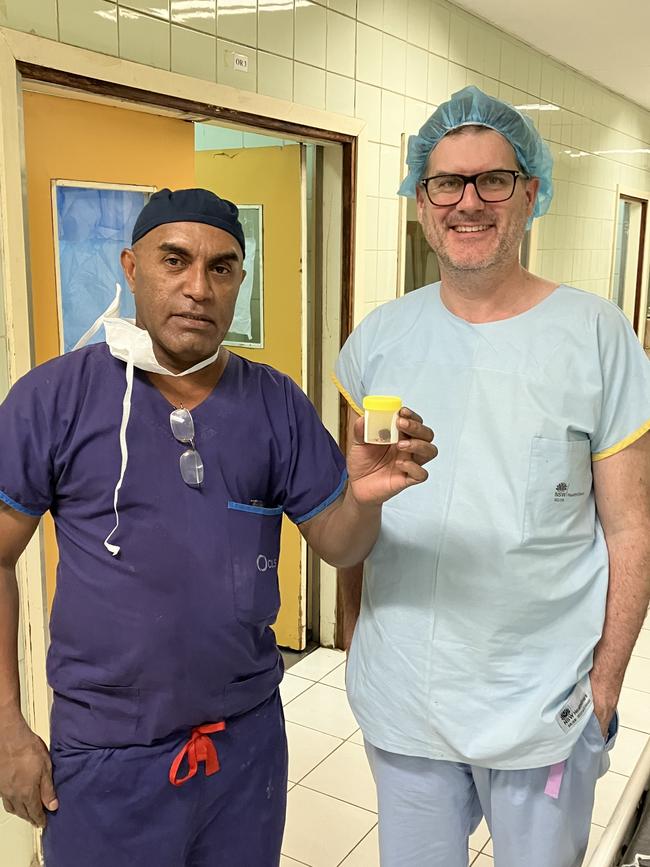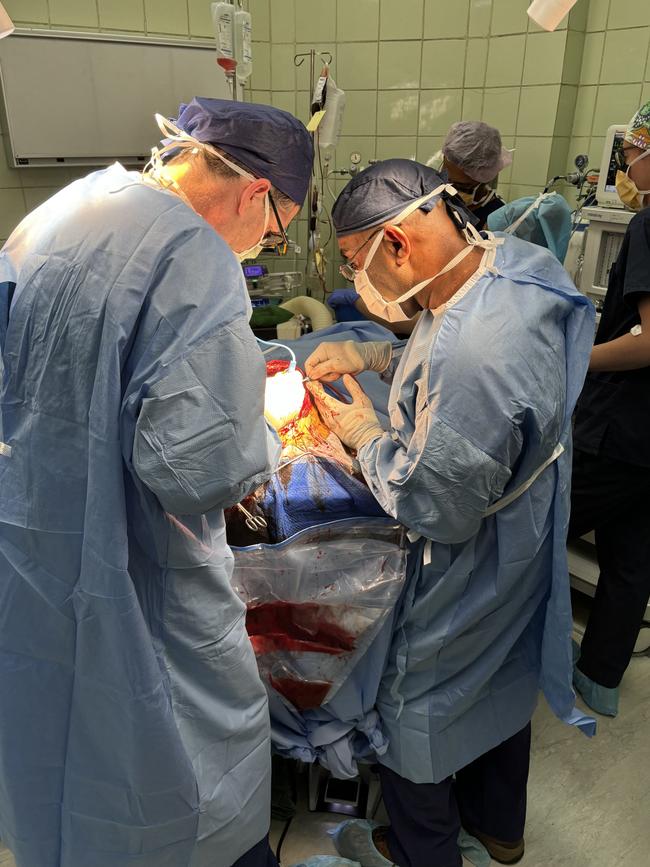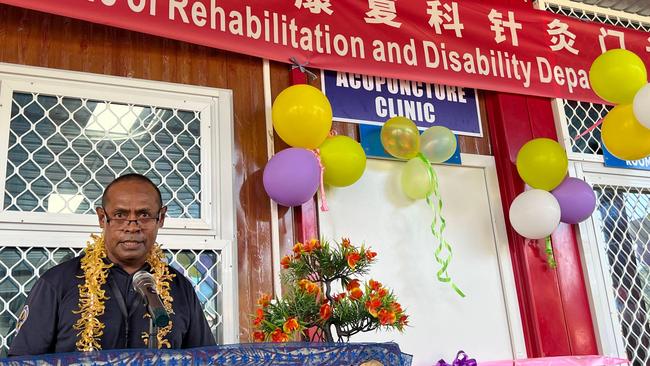Inside the strange world of soft power in the Pacific
Inside a Chinese-built hospital, a crack team of Australian doctors and surgeons perform lifesaving surgery on a young Solomon Islander boy. There’s a battle going on for hearts and minds here – who’s winning?

When I was a boy of seven, my late art-dealer father Ray Hughes took me to Papua New Guinea to buy shields in the highlands. At his memorial service at the Art Gallery of NSW in Sydney, a fellow traveller on that trip told me how close we’d come to being murdered by Raskols who pulled us over late at night on the road to Goroka. I’d been asleep, unaware of the dangerous situation. She explained that my father had given the bandits all the money in his top pocket in exchange for our lives. The Raskols were content and allowed us to proceed. I grimaced at the recollection; he always had about $200 in his top pocket, but would have had three or four thousand stashed in the secret pocket in his pants.
The clearest memory of that trip was a resident of the Hideaway Hotel in Port Moresby – a man we dubbed the Colonel. Dad encouraged my espionage-fuelled fantasy that the Colonel, dressed in chinos and a garish Hawaiian shirt, was a CIA man. Much to Dad’s amusement I tailed, harassed and aped him relentlessly the whole week we were in town. He was probably only a retired pig farmer from Wisconsin, but to seven-year-old me he was the most exotic creature I’d ever encountered.
Ever since, I’ve been intrigued by those who turn up in far-flung parts. So when my friend told me he was off to the Solomon Islands, I invited myself along before I even knew about his mission to lead a group of 12 doctors on their second visit there to perform neurosurgical operations. All were volunteering their time and were supported by generous donors, with some covering their own expenses.
We landed in Honiara at the Henderson Field airstrip, where ferocious fighting took place between US and Japanese soldiers during World War II. Later, from the Coral Sea bar where I sat with my friends, we gazed out at Ironbottom Sound – so named for the dozens of Allied and Japanese warships that lie beneath the placid waters.
This country, a former British protectorate, is home to around about three quarters of a million people. It is as breathtakingly beautiful as it is heartbreakingly bereft. But despite the poverty experienced across the archipelago of nearly 1,000 islands, not all inhabited, there is a solemn and uplifting community spirit. The Solomon Islanders possess a sense of civic and democratic pride that at times can boil over into violent unrest.
Today, 80 years after the war ended, there’s a battle going on here for hearts and minds. If the Pacific Islands are the squares on the board of a new Great Game between the dominant and emergent forces of West and East, in which influence is traded for naval support, it feels to me that China is engaged in a chess tournament while Australia is playing cards, so different are our styles of performing soft-power diplomacy.
I spent most of day one in scrubs, watching my friend’s dedicated team successfully remove an enormous tumour from the brain of a four-year-old boy. The clinics that the lead surgeon took at the National Referral Hospital were performed in a building recently erected by the Chinese, and the patients were cared for post-operatively by an Aussie nurse in the Australian Government’s High Dependency Unit.
It is a confronting, and I imagine a rare thing to watch someone pump their own blood into another living person. I recall the stillness in the room, and the sound of anaesthetist Bradley’s fist steadily squeezing and releasing a rubber device. He was sending his O-type blood, taken some time earlier, into the young patient. By this point I had been standing still in the corner of a tiled octagonal room for some hours. It was the middle of a hot Pacific afternoon and the National Referral Hospital’s operating theatre might well have been the most temperate place in Honiara.

The hospital’s blood bank had run dry and two of the fellows whose blood matched had placed themselves on a roster for the process of donating. The Australian High Commission,whose nurse runs the intensive care ward at the hospital, had also arranged a blood drive. If this four-year-old boy gets through the procedure, I thought, he might one day tell people the story of how a team of Australians landed in Honiara one night and saved his life the next day. If he grows up and throws around a rugby ball, he may claim his skill owes to the fact that Aussie blood beats through his Island heart. If he gets through this operation.
I’d met this beautiful little boy and his parents earlier in the day at a clinic run by Dr Matthew Tait, a neurosurgeon at Nepean Hospital in Western Sydney. I enjoyed exchanging silly faces with him as his parents and Tait discussed his issues through another doctor who spoke English and pidgin. I remember a smiling, shy, friendly boy whose eyes betrayed an acute consciousness of the momentous nature of the visit he and his parents had made. They’d flown from the island of Gizo, capital of the Western Province of the Solomon Islands, very near to where John F Kennedy’s patrol torpedo boat PT-109 was sunk in World War II. They came purely in the hope that he might be one of those able to be treated by the Aelan Neurosurgical Team, a group of volunteer doctors and nurses from the Nepean and Macquarie Hospitals in Sydney. His operation would be the first one performed on this second mission of theirs to the Solomon Islands.
Many of the team in Honiara had been present in November 2023 when the first mission was conducted. It followed the Solomon Islands’ acquisition of a CT scanner that had identified an alarming number of critical neurological conditions requiring immediate surgical intervention. The main aim at the time of that first visit, according to Tait, was “to establish what we could and couldn’t do … and to provide a service we can do over and over”.
Dr Narko Tutuo, an anaesthetist from the Nepean, is very much the driving force behind this altruistic mission. A Solomon Islander from the Western Province, his radiant smile lifts every room he walks into. At every moment of low energy or high tension during the week I spent with the team, the smiling Tutuo applied the laughing gas I suppose. And the more time I spent with this enigmatic and optimistic man, I realised it was not a purely personal trait. I did not encounter a single soul in the Solomons who did not smile with me, tell me a joke or make me grin with them. The happy isles, as the place is known, is not mere tourism marketing.


Tait would operate alongside Dr Micky Olangi, from Malaita. He was deeply committed to the clinic I attended; his jovial nature, too, lightened the solemnity as much as it could. The four-year-old patient’s skull was the size of a large football, elongated by a tumour; Tait informed the boy’s parents that it would have to be urgently removed.
That conversation took place in a room overlooking the coast, one of a series of prefab office clinics with the Chinese construction firm’s branding still on the seals. Later Tait would concede he hadn’t factored that, as a non-medical person, I might have found some of this quite confronting. I told him that I’d been in a similar situation before, at the Randwick Children’s Hospital in Sydney when my wife and I were told that our son, who was four days old, would require heart surgery almost at once or he would die. A decade later and a world away, I saw the same frozen shock in the eyes of the young boy’s parents.
Tait is a no-nonsense British-born clinician whose laconic warmth made his new patients feel at ease. He saw a series of five or six more patients that morning as I took notes and stared out at the Coral Sea. In many cases, where the stakes were so high, I sensed relief in many faces: that an answer to their ailment had come, a solution was possible and they would have a result one way or another.
Soon the consultations were over and the day was beginning to become oppressively hot. I was garbed in surgical scrubs emblazoned with NSW Health on the breast. The hospital washroom was very modest but had a full-length mirror. I had a flashback to myself as a young dad a decade ago, holding a little boy after an emergency C-section. Today, though, I was going to observe a complex surgery on another little boy. I suddenly wanted to leave the professionals to their work, and run and hide at the hotel and be the adventuring tourist who makes it as far as the intrepid waters of the poolside bar. But around me I watched as the team took to their duties as if they were back in Penrith. Every member of the squad had a job to do, and steady confidence in their skill.
I busily scrawled notes on the proceedings unfolding around me, recording anything – sounds, dialogue, even smells, if only not to focus directly on the reality of the procedure.
2:03pm: Standing. 19 pax incl me … Making myself as scarce as possible … There is such command, such calm. Matt [Tait] shows. Jokes. Humour – laughing … “Need a flexi, change it.” I watch a little chest rise and fall. Intubation. Silence has been called. Child is struggling. Narko fairly chilled – empowers younger team. My legs are absolutely killing me. A joke from someone. There is a blockage. Problem solving with Ian. Consequences made in split seconds. “I’m not seeing beating.” It is incomprehensible how conceptually abstract this little nondescript body is in this room.
These raw notes captured only the lead-up to surgery. At about 2:30pm the ink in my fountain pen ran out and I started to panic. Dr Ian Seppelt, one of the senior anaesthetists and possibly the most worried about how the non-medical person would react to the operation, handed me a biro so I could continue my notes.
Matt: “Clean line is so important.” Make a comment about art! Tension in the air as the moment comes closer. “Let’s Go.”

At this point my notes became more descriptive; the magnitude of watching a life in the balance deserved grammar, if not perhaps the cringeworthy stream of emotional language that seemed impossible to stem.
He’s shrouded by a yellow transparent sheet of plastic that has transformed the young boy into an indeterminate mass of hope.
This was a particularly difficult neurosurgical intervention on a young child – and the first such procedure in the Solomon Islands. I was aware of the thick air of tension that had built among the dozen Australian doctors here. It seemed all were acutely conscious that the little boy was losing blood.
By 3:08pm I noted that there was a “lull in tension. Matt seems relaxed”. But between 3:25pm and 3:48pm there was enormous activity focused on the boy’s heavy bleeding. I recorded numerous times the sound of suction and the foreign smell I’d never previously encountered, but which I realised at 3:31pm was that of burning flesh, cauterisation being a necessary part of the surgical work.
3:57: Brad, who has been literally pumping blood into this little boy, leaves the team to give blood. Laura has just returned and her blood is about to go into the child.
The next half-hour, as the notes detailed, was the critical period.
4:03: A tumour the size of an oxheart has just been removed – all stand astounded. Everyone is so relaxed now. “It’s about all out.” Blood is running low. Matt is in good humour.
4:12: More blood called for.
4:24: Blood pressure down. We’re catching up.
4:38: I have gone to talk to Narko about Solomons politics (because I can’t take it anymore).
My notes show that at 4:45pm, one of the anaesthetists came into the room next to the operating theatre where I’d been talking politics, to get some equipment. He was fetching the team’s speaker and Narko smiled broadly because he knew what it meant: the music was to bring the rest of the team back down – the surgery had been a success. I went in with Narko soon after and rap was playing, Tait was clearing things away methodically and the babble of the team had replaced the suction and sounds of the machinery. There was life back in that room, and indeed in the little boy.
Another three such operations lay ahead in the coming days, each one taking several hours.
While the neurosurgeons continued to save lives, I decided to take a taxi back to the hotel. As we drove through dusty, low-rise Honiara – nestled between its port and the dramatic backdrop of lush green mountains – I passed kangaroo signs denoting Australian aid support, Chinese surveyors outside the port, and a group of white university medical students in scrubs marching towards the hospital. I asked the driver what he thought of all the new construction work going on.
“It’s a good stadium, but nobody goes there,” he said, pointing to the facility built by the Chinese for the 2023 Pacific Games. I smiled and replied: “Every great city in the world has one of those.”
Honiara is a strangely attractive place. It doesn’t have the Brutalist relics of the ’60s that dot Africa’s capitals, resonating the influx of mineral and resources wealth alongside a smattering of CIA and KGB largesse during the post-war years. It is not a city that exists to service a network of resorts for Australian tourists seeking to escape the winter months, yet. It consists of one long street facing the sea with dramatic hills behind it, only two half-decent hotels and not much in the way of things to do after dark. So exactly like Noosa but with better food and more interesting locals.

A friend of mine at the World Bank who has worked with the Solomon Islands put it to me this way: “It’s a place whose natural beauty is matched only by its heart-rending poverty.” It is certainly an extraordinarily beautiful part of the world. I made a point of waking early each day I was there to watch sunrises that would make Paul Gauguin blush at the implausibility of their palette. At night the sky would turn deep purple. The water was an aquamarine that can barely be described. I asked my driver whether it was safe to go diving. He grinned and said: “Of course – as long as you’re nice to the sharks.” The coat of arms of the Solomon Islands features a shark and a crocodile.
There are a number of organisations like Aelan Neurosurgery doing work in the Pacific. I sense that the best course of action would be to build a cohesive body that can bring these groups together with the aid community, to create a coordinated corpus of capital and a supportive government to help open doors.
One feels that to some Australian government types, soft power means bags of grain with kangaroos emblazoned on the packaging. Others see it as the cables and pipes that are laid by Australia, though these are buried so deeply that no one knows they are there or who paid for them. In other words, the aid and infrastructure projects deployed by Australia are incredibly effective but could be marketed a little better. Australia has always been good at quiet and effective aid programs, but whether that’s the best strategy in the new Great Game in the Pacific is debatable.
But in terms of soft power, are these things as effective as the knowledge that a community in the Solomons has that a bunch of Aussies flew out on their own dime and saved one of their sons? On the last day of the surgical procedures, we were given very beautiful shell necklaces from Gizo, where that little boy was from. I was wearing mine as I walked alone through the museum before flying out. The lady at the desk in the gift shop pointed at it and said to me: “Wow, you must have done something good – that is a special thank you from the Western Province.”
There will not be another mission this year, as the hospital in Honiara will be undergoing reconstruction with funding from the Chinese government. The next journey we make, hopefully in March 2025, will be to Gizo. Most of the Australian team will come back to the Solomons as long as missions like this can be done sustainably. There will need to be more reliable planning and funding support. The next mission will also require a mobile CT scanner to be sourced, shipped and transported internally. The logistical challenges are considerable, but not insurmountable. If Tait can look at a scan of the inside of someone’s head, determine what needs to be done, open a small skull, spend several hours successfully removing the tumour while battling significant blood loss, and ultimately give a little boy a future – and carry out multiple other operations that week, too – then I can try and work out how to get us back to the islands to do it all again. After all, wrangling donors and government isn’t brain surgery.
I changed out of my scrubs and walked to the Heritage Park Hotel where a UN conference for new parliamentarians was underway. One wag at the bar mused it was a conference on how to decentralise corruption. I rolled my eyes and took myself to the best Chinese restaurant in town, Xiao Qingdao.
Perhaps it was my green velvet slippers with a kangaroo and emu (one embroidered on each toe) that put the owner off me, but her suspicion subsided when I asked her to feed me the good stuff. Still sceptical, she nevertheless laid before me some cumin-dusted lamb ribs – easily the best version of the famous Xinjiang dish I’d been served since I was in Beijing, when the famous painter Liu Xiaodong arranged for a whole lamb to be barbecued in that manner for my father and me. I didn’t ask her thoughts on the issue of Xinjiang’s Uyghur people, considering she had just served me such good food.

By late evening I was rather knocked around by the malaria tablets, which were unkind to my stomach, perhaps aided by the Maker’s Mark bourbon consumed to wash them down. In the palm-fringed open-air hotel bar beside the moonlit indigo Coral Sea, two jovial Chinese gentlemen gestured to one another in an animated, if hushed, fashion. They were defiantly putting on a show for an Anglo-looking chap in a drab cap, T-shirt and shorts. In turn he coolly smiled whenever he looked up from his book to meet their intermittent gaze. At his elbow was a bucket of four Coronas, a fifth in his hand – a more useful tool of his tradecraft than the paperback – indicating he was not going anywhere. I sat staring at both, remembering my father and the Colonel in PNG as I sweated into my handmade Zink & Sons seersucker suit, watching a spy watch spies, watching a spy. They could have been a diver from California visiting the pristine reefs of the west coast of Guadalcanal and two enterprising Chinese businessmen involved in legitimate import export. Probably. Just another ordinary Monday night in the Solomons.



